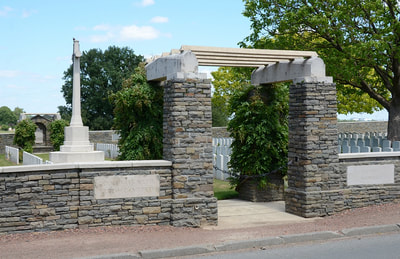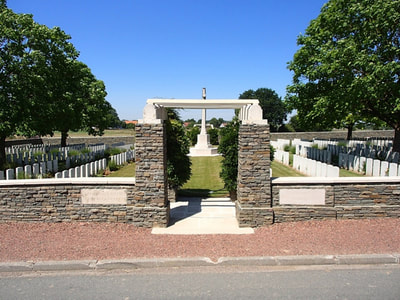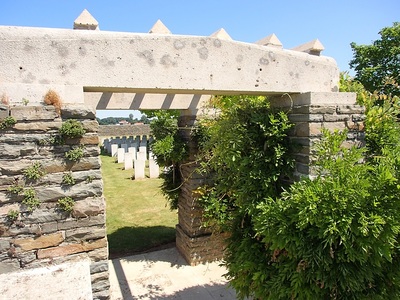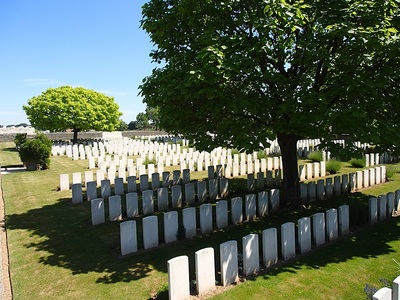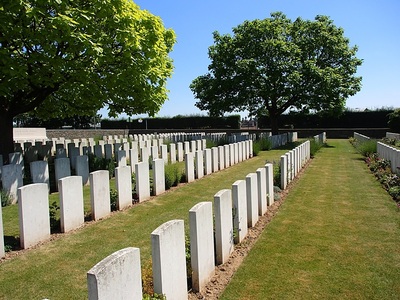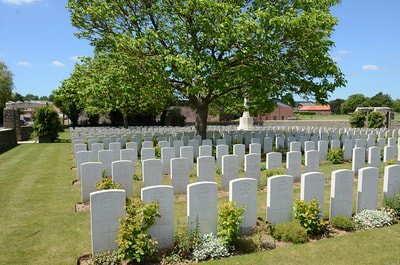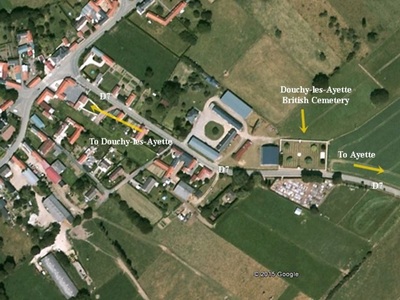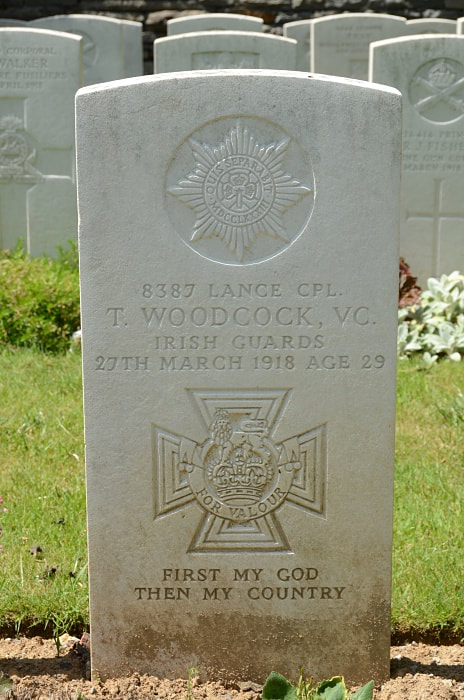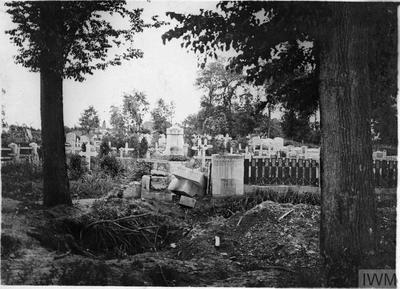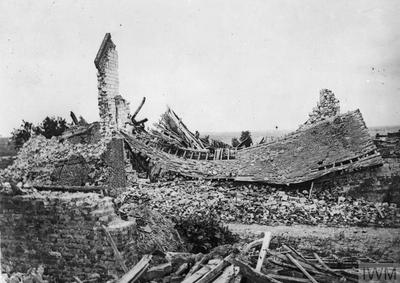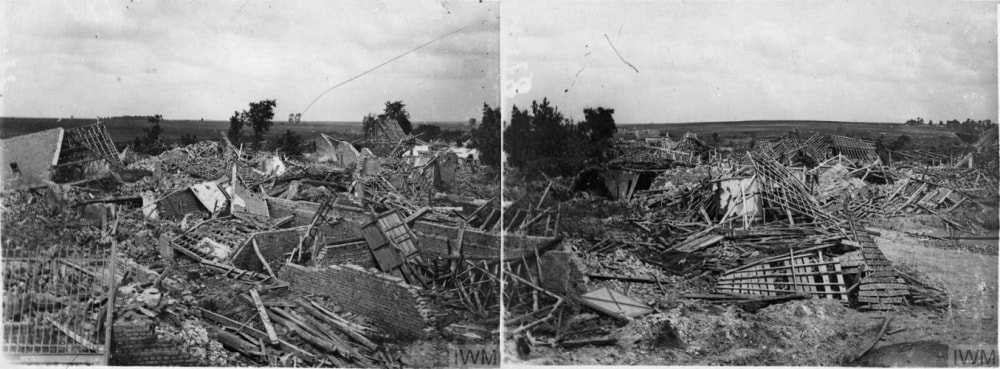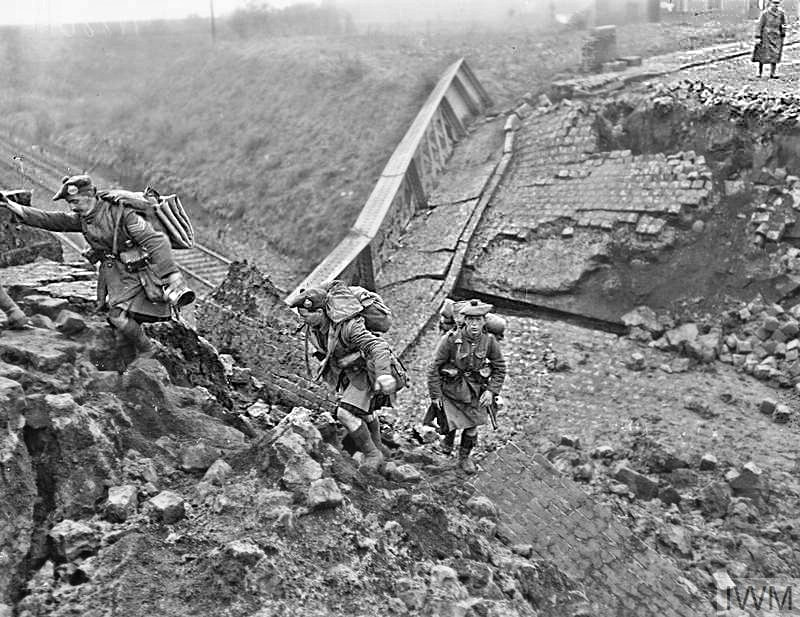DOUCHY-LÈS-AYETTE BRITISH CEMETERY
Pas De Calais
France
Location Information
Ayette is a village some 13 kilometres south of Arras on the road to Amiens, and Douchy-les-Ayette is a village 1 kilometre west of Ayette.
The British Cemetery is opposite the Communal Cemetery on the north side of the road, halfway between the two villages next to a barn.
Historical Information
Douchy-les-Ayette was in German occupation from October, 1914 to the 21st March, 1917. In March, 1918, the enemy advanced as far as the Communal Cemetery, and held it for a few days. The village was never completely evacuated by the inhabitants. It contained a German Cemetery of 380 graves, now removed.
The British Cemetery was begun in August and September, 1918, by the 3rd Division Burial Officer; and the 81 graves then made are scattered among eight Rows in what are now Plots II and IV. It was enlarged after the Armistice by the concentration of graves from the battlefields of Arras and the Ancre and from other burial grounds, including:-
BRASSERIE MILITARY CEMETERY, LE FERMONT, RIVIERE, on the Bretencourt-Wailly Road, begun by French troops, which contained the graves of ten soldiers from the United Kingdom who fell in April, 1916, and one who fell in January, 1918.
FAVREUIL GERMAN CEMETERY, at the North-East corner of the village, contained the graves of 389 German soldiers and of four from the United Kingdom and one from Canada, buried by the enemy in 1916.
FREMICOURT COMMUNAL CEMETERY, in which 20 German soldiers and two R.F.C. officers (who died in 1916 in a German hospital in the Church) were buried.
GASTINEAU FARM FRENCH MILITARY CEMETERY, RANSART, on the Bellacourt-Berles road, in which one soldier from the United Kingdom was buried in February, 1916.
GOMIECOURT GERMAN CEMETERY, a little West of the village, in which 126 German soldiers and 27 from the United Kingdom were buried in 1916-18.
GROSVILLE CHURCHYARD, RIVIERE, in which two men of the Liverpool Scottish were buried by their comrades in February, 1916.
L'ALOUETTE FRENCH MILITARY CEMETERY, RANSART, on the Bellacourt-Berles road, in which ten soldiers from the United Kingdom were buried by their comrades in 1916.
MORCHIES COMMUNAL CEMETERY GERMAN EXTENSION, containing the graves of 400 German soldiers, five Australian and one from the United Kingdom, who fell in 1916-17.
MOYENNEVILLE GERMAN CEMETERY (one of several in the Commune), in the South-West part of the village, in which eleven soldiers from the United Kingdom (including six R.F.C.) were buried by the enemy in 1916-17.
RANSART CHURCHYARD, in which one soldier from the United Kingdom was buried in March, 1917.
RANSART M.D.S. CEMETERY, in the village, where 12 soldiers from the United Kingdom were buried at the end of August, 1918.
SAPIGNIES GERMAN CEMETERY, in the South-West corner of the village, contained the graves of 28 soldiers from the United Kingdom (including two R.N.D.), who fell in 1916-18, and 840 German soldiers.
WAILLY MILITARY CEMETERY, at the North-East end of the village, contained 30 French graves and those of 23 men of the 55th Division who fell in 1916.
WILLOW ROAD CEMETERY, BOIRY-STE. RICTRUDE, in which 25 soldiers from the United Kingdom (largely of the Guards Division) were buried in 1918.
There are now over 700, 1914-18 war casualties commemorated in this site. Of these, nearly one-third are unidentified and a special memorial is erected to an officer of the Lincolns believed to be buried among them.
Certain graves in Plot I, Row A and B, identified collectively but not individually, are marked by headstones bearing the additional words: "Buried near this spot...".
The Cemetery covers an area of 2,418 square metres and is enclosed by a rubble wall.
The cemetery was designed by Sir Edwin Lutyens & George Hartley Goldsmith
Casualty Details: UK 727, Canada 1, Australia 5, South Africa 2, Germany 1, Total Burials: 736
Ayette is a village some 13 kilometres south of Arras on the road to Amiens, and Douchy-les-Ayette is a village 1 kilometre west of Ayette.
The British Cemetery is opposite the Communal Cemetery on the north side of the road, halfway between the two villages next to a barn.
Historical Information
Douchy-les-Ayette was in German occupation from October, 1914 to the 21st March, 1917. In March, 1918, the enemy advanced as far as the Communal Cemetery, and held it for a few days. The village was never completely evacuated by the inhabitants. It contained a German Cemetery of 380 graves, now removed.
The British Cemetery was begun in August and September, 1918, by the 3rd Division Burial Officer; and the 81 graves then made are scattered among eight Rows in what are now Plots II and IV. It was enlarged after the Armistice by the concentration of graves from the battlefields of Arras and the Ancre and from other burial grounds, including:-
BRASSERIE MILITARY CEMETERY, LE FERMONT, RIVIERE, on the Bretencourt-Wailly Road, begun by French troops, which contained the graves of ten soldiers from the United Kingdom who fell in April, 1916, and one who fell in January, 1918.
FAVREUIL GERMAN CEMETERY, at the North-East corner of the village, contained the graves of 389 German soldiers and of four from the United Kingdom and one from Canada, buried by the enemy in 1916.
FREMICOURT COMMUNAL CEMETERY, in which 20 German soldiers and two R.F.C. officers (who died in 1916 in a German hospital in the Church) were buried.
GASTINEAU FARM FRENCH MILITARY CEMETERY, RANSART, on the Bellacourt-Berles road, in which one soldier from the United Kingdom was buried in February, 1916.
GOMIECOURT GERMAN CEMETERY, a little West of the village, in which 126 German soldiers and 27 from the United Kingdom were buried in 1916-18.
GROSVILLE CHURCHYARD, RIVIERE, in which two men of the Liverpool Scottish were buried by their comrades in February, 1916.
L'ALOUETTE FRENCH MILITARY CEMETERY, RANSART, on the Bellacourt-Berles road, in which ten soldiers from the United Kingdom were buried by their comrades in 1916.
MORCHIES COMMUNAL CEMETERY GERMAN EXTENSION, containing the graves of 400 German soldiers, five Australian and one from the United Kingdom, who fell in 1916-17.
MOYENNEVILLE GERMAN CEMETERY (one of several in the Commune), in the South-West part of the village, in which eleven soldiers from the United Kingdom (including six R.F.C.) were buried by the enemy in 1916-17.
RANSART CHURCHYARD, in which one soldier from the United Kingdom was buried in March, 1917.
RANSART M.D.S. CEMETERY, in the village, where 12 soldiers from the United Kingdom were buried at the end of August, 1918.
SAPIGNIES GERMAN CEMETERY, in the South-West corner of the village, contained the graves of 28 soldiers from the United Kingdom (including two R.N.D.), who fell in 1916-18, and 840 German soldiers.
WAILLY MILITARY CEMETERY, at the North-East end of the village, contained 30 French graves and those of 23 men of the 55th Division who fell in 1916.
WILLOW ROAD CEMETERY, BOIRY-STE. RICTRUDE, in which 25 soldiers from the United Kingdom (largely of the Guards Division) were buried in 1918.
There are now over 700, 1914-18 war casualties commemorated in this site. Of these, nearly one-third are unidentified and a special memorial is erected to an officer of the Lincolns believed to be buried among them.
Certain graves in Plot I, Row A and B, identified collectively but not individually, are marked by headstones bearing the additional words: "Buried near this spot...".
The Cemetery covers an area of 2,418 square metres and is enclosed by a rubble wall.
The cemetery was designed by Sir Edwin Lutyens & George Hartley Goldsmith
Casualty Details: UK 727, Canada 1, Australia 5, South Africa 2, Germany 1, Total Burials: 736

8387 Lance Corporal Thomas Woodcock, V. C.
2nd Bn. Irish Guards, died 27th March 1918, aged 29. Plot IV. F. 3.
Son of Henry and Isabella Woodcock; husband of Mary Woodcock, of 41, Cambridge St., Wigan. A scholar at St. Patrick's School.
Citation: An extract from the "London Gazette," dated 16th Oct., 1917, records the following:-"For most conspicuous bravery and determination. He was one of a post commanded by Lce. Serjt. Moyney, which was surrounded. The post held out for 96 hours, but after that time was attacked from all sides in overwhelming numbers and was forced to retire. Pte. Woodcock covered the retirement with a Lewis gun, and only retired when the enemy had moved round and up to his post and were only a few yards away. He then crossed the river, but hearing cries for help behind him, returned and waded into the stream amid a shower of bombs from the enemy and rescued another member of the party. The latter he then carried across the open ground in broad daylight towards our front line regardless of machine gun fire that was opened on him."
2nd Bn. Irish Guards, died 27th March 1918, aged 29. Plot IV. F. 3.
Son of Henry and Isabella Woodcock; husband of Mary Woodcock, of 41, Cambridge St., Wigan. A scholar at St. Patrick's School.
Citation: An extract from the "London Gazette," dated 16th Oct., 1917, records the following:-"For most conspicuous bravery and determination. He was one of a post commanded by Lce. Serjt. Moyney, which was surrounded. The post held out for 96 hours, but after that time was attacked from all sides in overwhelming numbers and was forced to retire. Pte. Woodcock covered the retirement with a Lewis gun, and only retired when the enemy had moved round and up to his post and were only a few yards away. He then crossed the river, but hearing cries for help behind him, returned and waded into the stream amid a shower of bombs from the enemy and rescued another member of the party. The latter he then carried across the open ground in broad daylight towards our front line regardless of machine gun fire that was opened on him."
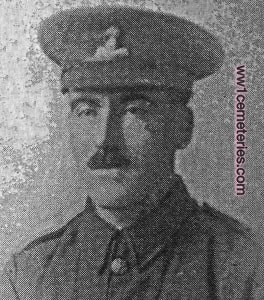
Lieutenant
George Victor Butler
2nd/5th Bn. Lincolnshire Regiment
23rd March 1918, aged 29.
Sp. Mem.
Son of Joseph Marshall MacDermott Butler and Margaret Mary Butler, of 3, Rhoda Villas, Sutton, Co. Dublin.
His parent added the following inscription to his headstone; "Faithful unto Death."
George Victor Butler
2nd/5th Bn. Lincolnshire Regiment
23rd March 1918, aged 29.
Sp. Mem.
Son of Joseph Marshall MacDermott Butler and Margaret Mary Butler, of 3, Rhoda Villas, Sutton, Co. Dublin.
His parent added the following inscription to his headstone; "Faithful unto Death."
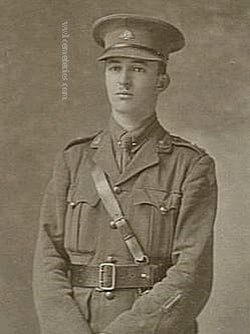
Captain
William Henry Gartrell
26th Bn. Australian Infantry, A. I. F.
18th November 1916, aged 23.
Plot III. E. 1.
Son of Henry George Gartrell, of Aplin St., Charters Towers Queensland, and the late Rhoda Gartrell.
Died in a German Field Hospital of severe head wounds and originally buried with Military Honours at Morchies Cemetery by the Germans.
William Henry Gartrell
26th Bn. Australian Infantry, A. I. F.
18th November 1916, aged 23.
Plot III. E. 1.
Son of Henry George Gartrell, of Aplin St., Charters Towers Queensland, and the late Rhoda Gartrell.
Died in a German Field Hospital of severe head wounds and originally buried with Military Honours at Morchies Cemetery by the Germans.
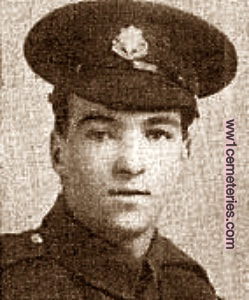
19/1473 Private
John William Glover
13th Bn. Northumberland Fusiliers
30th March 1917, aged 27.
Plot IV. H. 18.
Son of William Glover, of g Brudenell Rd., Hyde Park, Leeds.
John William Glover
13th Bn. Northumberland Fusiliers
30th March 1917, aged 27.
Plot IV. H. 18.
Son of William Glover, of g Brudenell Rd., Hyde Park, Leeds.
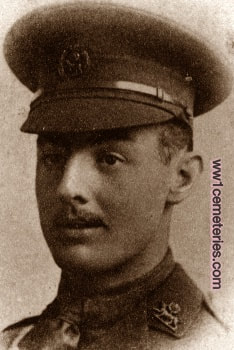
Second Lieutenant
Douglas Roy Hinckley
5th Sqdn. Royal Flying Corps and 12th Bn. York and Lancaster Regiment
13th January 1917, aged 21.
Plot III. C. 16.
Son of John and Jeanie Anne Percy Hinckley. The inscription on his headstone reads; "He Honoured his Country's Word."
Douglas Roy Hinckley
5th Sqdn. Royal Flying Corps and 12th Bn. York and Lancaster Regiment
13th January 1917, aged 21.
Plot III. C. 16.
Son of John and Jeanie Anne Percy Hinckley. The inscription on his headstone reads; "He Honoured his Country's Word."
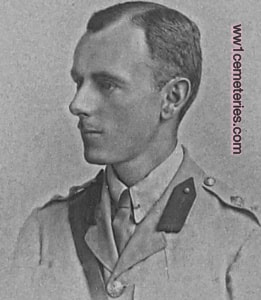
Captain
Claude Jeffery Keeping
8th Bn. Middlesex Regiment
24th August 1918, aged 34.
Plot I. B. 13.
Son of Tom Jeffery and Eveline Elizabeth Keeping, of Staines; husband of Marjorie Gladys Cobbold Keeping, of Fairfield Lodge, Staines, Middx. The inscription on his headstone reads; "Gone but Not Forgotten."
Claude Jeffery Keeping
8th Bn. Middlesex Regiment
24th August 1918, aged 34.
Plot I. B. 13.
Son of Tom Jeffery and Eveline Elizabeth Keeping, of Staines; husband of Marjorie Gladys Cobbold Keeping, of Fairfield Lodge, Staines, Middx. The inscription on his headstone reads; "Gone but Not Forgotten."
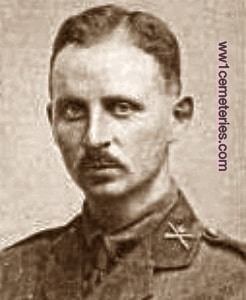
Captain
John Wilson Lawson, M. C.
41st Bn. Machine Gun Corps (Infantry)
24th March 1918, aged 29.
Plot III. D. 1.
Son of Matthew Henry and Jeanie Watson Lawson, of Bank House, Dunning, Perthshire; husband of Katharine Noel Lawson (nee Wilson), 16, Craiglockhart Terrace, Edinburgh. Enlisted Nov., 1914. Gazetted May, 1915, in Black Watch; also served in Italy.
His wife added the following inscription to his headstone; "Of Dunning, Perthshire. Beloved husband of K. Noel Lawson."
John Wilson Lawson, M. C.
41st Bn. Machine Gun Corps (Infantry)
24th March 1918, aged 29.
Plot III. D. 1.
Son of Matthew Henry and Jeanie Watson Lawson, of Bank House, Dunning, Perthshire; husband of Katharine Noel Lawson (nee Wilson), 16, Craiglockhart Terrace, Edinburgh. Enlisted Nov., 1914. Gazetted May, 1915, in Black Watch; also served in Italy.
His wife added the following inscription to his headstone; "Of Dunning, Perthshire. Beloved husband of K. Noel Lawson."

Second Lieutenant
Hugh Vaughan Massie, M. M.
22nd Bn. Australian Infantry, A. I. F.
8th March 1917, aged 24.
Plot III. E. 2.
Son of Frank Hamilton Massie and Mary Agnes O'Neill Massie. Born at Sale, Victoria.
The inscription "Requiescat in Pace" was added to his headstone
2332 Private T. J. Campbell gave this description of the circumstances leading to the death of Hugh Massie; "Lt. Massie was out on patrol on this side of the Butte de Warlencourt, he had two other men with him. They met a party of Germans and the Germans started to bomb them. The two scouts were both wounded but managed to get back to our line but Lt. Massie did not return and was no doubt killed."
Other men described Lt. Massie being to badly wounded to get back to his own lines and that they were unable to get him back themselves. The Australians took the trench that Hugh Massie had been attacking the following day but found no trace him.
In fact, Hugh Massie had been severely wounded in the bomb fight, receiving wounds to the head. He was taken prisoner and died of his wounds. He was originally buried by the Germans at Morchies Cemetery.
Hugh Vaughan Massie, M. M.
22nd Bn. Australian Infantry, A. I. F.
8th March 1917, aged 24.
Plot III. E. 2.
Son of Frank Hamilton Massie and Mary Agnes O'Neill Massie. Born at Sale, Victoria.
The inscription "Requiescat in Pace" was added to his headstone
2332 Private T. J. Campbell gave this description of the circumstances leading to the death of Hugh Massie; "Lt. Massie was out on patrol on this side of the Butte de Warlencourt, he had two other men with him. They met a party of Germans and the Germans started to bomb them. The two scouts were both wounded but managed to get back to our line but Lt. Massie did not return and was no doubt killed."
Other men described Lt. Massie being to badly wounded to get back to his own lines and that they were unable to get him back themselves. The Australians took the trench that Hugh Massie had been attacking the following day but found no trace him.
In fact, Hugh Massie had been severely wounded in the bomb fight, receiving wounds to the head. He was taken prisoner and died of his wounds. He was originally buried by the Germans at Morchies Cemetery.

